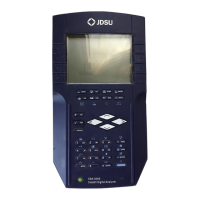Description and Basic Operation of the SDA-5500 and 5510: Basic Modes of Operation
235
13
performed with each scan update. However, a Check soft key is provided to
repeat the limit check whenever desired.
The Limits On/Off soft key toggles the limit check feature on and off. When
turned off, the limit annunciators do not appear.
Measuring the Carrier to Noise Ratio
It is a good engineering practice to use a bandpass filter on the input of the
receiver when making C/N measurements to ensure accuracy and extend
measurement range. If a preamplifier is used to boost test point levels prior
to measurement, it should be placed between the bandpass filter and the
receiver. This measurement is simply a comparison in amplitude between
the video carrier reference signal and the noise (FCC limit: > 43 dB). The
noise measurement should be made at least 2 to 2.5 MHz from any other
carrier on the system.
In C/N mode, the carrier to noise ratio of the tuned channel or frequency is
displayed (see Fig 13-11). The C/N measurement bandwidth and the
frequency offset for the noise measurement may be controlled from the
screen. A proprietary DSP technique allows C/N measurements on
modulated carriers (non-scrambled channels). The measurement is made
by measuring the video carrier level and then tuning to the offset frequency.
Once a line is found, the unit will then measure four consecutive frames and
average the values together. The value is then corrected for the selected
bandwidth, and the C/N ratio is computed. If the mode is selected before a
carrier is available on the input, it will cause the readings to be wrong. If this
occurs, change to another mode or channel and then return to the desired
channel.
Information displayed in the C/N mode is as follows:
• Channel number
• Channel label
• Carrier frequency
• Noise offset frequency
• Noise frequency
• Bandwidth
• C/N ratio
• Channel plan

